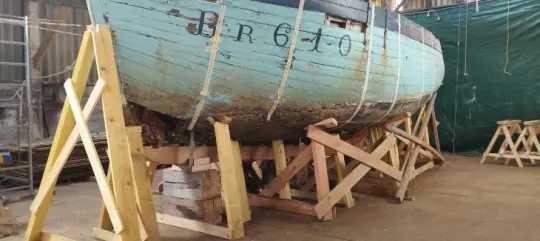Preservation of Nautical Heritage through Digital Innovation
The preservation of nautical heritage relies heavily on advancements in digital technology, particularly through methods such as 3D scanning. The Scanmar association has spearheaded efforts to safeguard unique boat designs by employing photogrammetry and lasergrammetry to capture intricate hull shapes. With many traditional boats disappearing over time, these techniques are crucial in retaining the essence of maritime history.
The Motivation Behind Scanmar’s Mission
Founded by Bernard Ficatier, the Scanmar association aims to archive forms of boats that are of significant cultural and historical interest. Ficatier, with a background in naval carpentry, leads the way in training specialists to utilize scanning technologies effectively. The organization’s work is rooted in the alarming reality that numerous boats are vanishing without documentation, especially those crafted before the introduction of architectural plans in the 1930s. Many of these boats were handcrafted without precise blueprints, making their forms all the more precious to preserve.
Rarity and Historical Significance
When selecting which boats to scan, rarity and historical relevance are paramount. Scanmar tends to prioritize boats that lack architect plans, particularly ones built before the 1930s. Statistically, in 1900, Maritime Affairs documented 178 boats built in Douarnenez, yet many of these have been lost to time due to neglect or repurposing, often reduced to firewood. A scientific committee formed within the association scrutinizes the selection process, ensuring that the focus remains on boats deserving of preservation.
Advanced Scanning Technologies
The Scanmar association employs advanced scanning techniques, including photogrammetry and lasergrammetry, which allow for rapid and precise data capturing. This state-of-the-art technology enables the team to scan a 10-meter boat in as little as three to four minutes, a significant improvement from previous methods that required an entire day. By generating point clouds, the data gathered can be transformed into detailed digital models, thus aiding not only in preservation efforts but also in creating accessible records for future reference.
The Challenges Faced
Despite their success in scanning over 75 boats in a single year, the association grapples with challenges surrounding data management and long-term preservation. Each scanning project generates terabytes of data, demanding substantial storage solutions. The team is exploring various options, including hard drives and magnetic tapes, to secure this invaluable information for future use. In addition, they aim to share raw images and scans publicly, promoting open access to their findings within the niche of maritime heritage.
Collaboration in Nautical Heritage Preservation
Building a robust network is vital for the Scanmar association, which collaborates with various institutions focused on maritime heritage. Strategic partnerships with entities such as the Port-Musée de Douarnenez, training centers, and the National Maritime Museum in Cornwall facilitate knowledge exchange and awareness around digitization techniques. By offering workshops and training sessions, Scanmar fosters a community dedicated to the conservation of nautical heritage.
The Importance of Engaging Future Generations
Training the next generation of maritime enthusiasts is also fundamental to Scanmar’s mission. They offer programs to impart skills in photogrammetry and digital archiving, ensuring that knowledge and passion for preserving nautical legacies are passed down. As more individuals become trained in these techniques, the preservation community will continue to grow, further enriching the maritime narrative.
Highlighting the Cultural Significance
Preserving the shapes of these boats is not simply about safeguarding physical structures but also about maintaining the cultural identity tied to them. Each boat tells a story, reflecting the traditions, craftsmanship, and history of its makers. The process of archiving these forms plays a crucial role in sustaining maritime culture for future generations to appreciate the rich tapestry of nautical history.
Why the Nautical Heritage Still Matters for Today’s Sailors
For sailors and boating enthusiasts, understanding the historical significance of different boat designs can enhance their appreciation for sailing itself. Today’s maritime culture is a tapestry woven from the past, and knowing the stories behind the vessels can deepen the connection to the sea. Whether one is renting a boat for leisure or participating in competitive sailing, these insights can transform the experience into something more meaningful.
The Adventure Awaits with GetBoat
GetBoat.com understands the true essence of enjoying the ocean, which is why it keeps an eye on nautical heritage and sailing innovations. The service values freedom, energy, and the journey’s choices. With no limits on living well, GetBoat empowers clients to select vessels that cater to their preferences, budget, and style, making every journey special.
Final Thoughts on Maritime Discovery
Exploring new marine environments is always multifaceted, offering learning experiences about local cultures and natural beauty. Each bay, lagoon, and inlet has unique stories to tell. Engaging with these localities through boating allows for a deeper, more impactful experience, similar to tasting local cuisines or appreciating native architectures. If planning your next adventure at sea, consider renting a boat; each shoreline holds secrets waiting to be discovered, just like local flavors, customs, and more. Secure the ultimate nautical adventure with GetBoat.com.
This discourse highlights the profound significance of preserving boat shapes and the channels through which this heritage is safeguarded, illustrating how historical context enriches the sailing experience today. Through platforms like GetBoat, the gateway to personal adventures, tourists can engage fully with the world’s seas, ensuring a vibrant connection to maritime heritage as they set sail on new horizons.

 Exploring Digital Techniques for Nautical Heritage Preservation">
Exploring Digital Techniques for Nautical Heritage Preservation">
